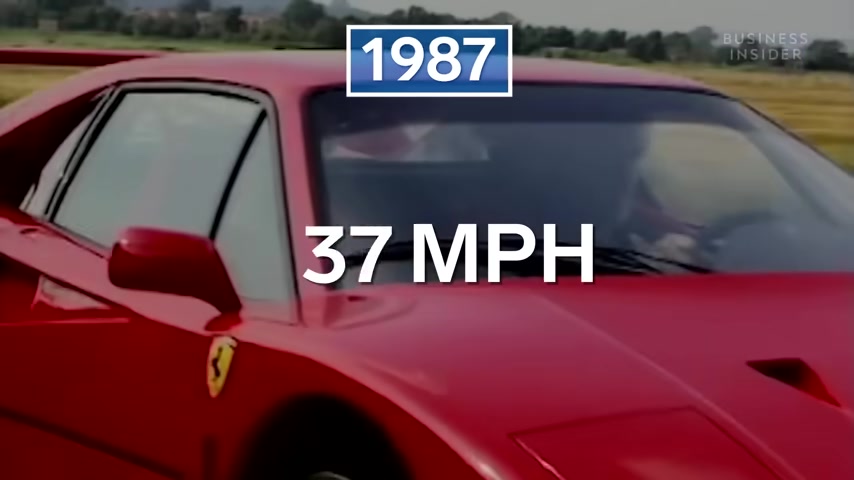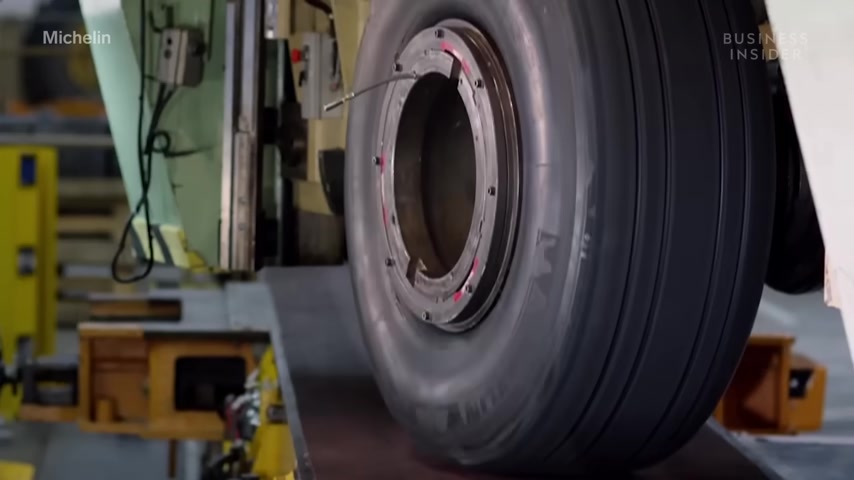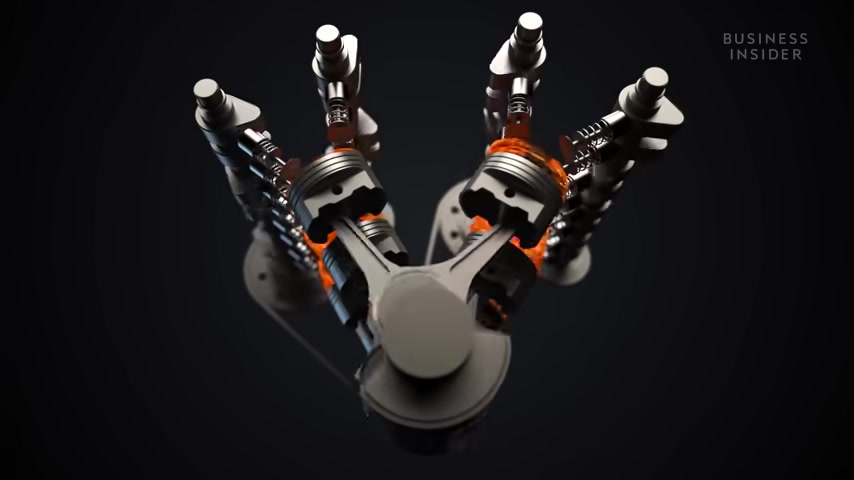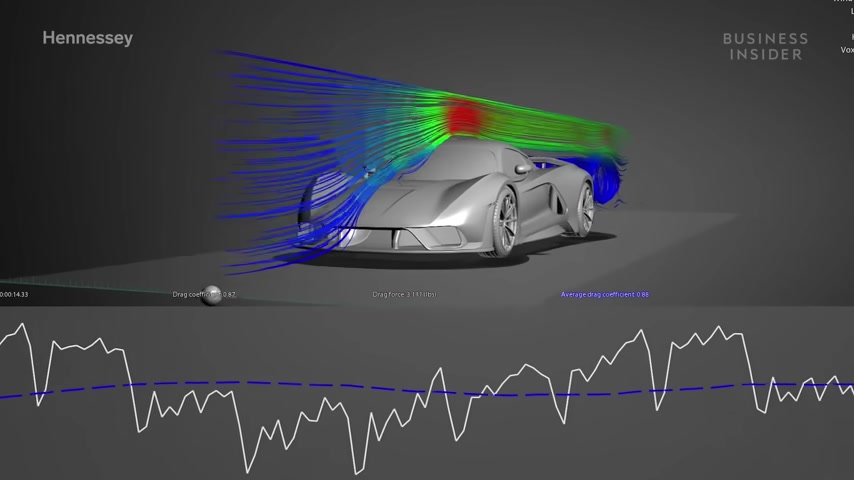https://www.youtube.com/watch?v=l5XP6T7xqek
Why It's Almost Impossible For Cars To Go 300 Miles Per Hour _ Insider Cars

In 1987 the Ferrari F 40 became the first street legal car to go 200 MPH .
In 2005 , Bugatti's Veyron Hyper car broke the 250 mile per hour barrier .
In late 2019 , the Bugatti Chiron Super Sport became the first production vehicle to ever reach 300 MPH .
But why has it taken almost 15 years just to go 50 MPH faster ?
You think about speed as a linear measurement and I suppose it should be to a , to a human brain .
But if you've ever gone 100 and 50 miles an hour before anywhere , if you then step that up just to 100 and 80 it's only 20% .
But the difference is huge .
That's Andy Wallace , the driver behind Bugatti's 300 mile per hour run aerodynamically , er , down force lift drag .
It's all increasing exponentially as a square of the speed .

If for example , you had a car that was capable of 270 miles an hour , the efficiency you need to take that same car up to 280 is pretty massive .
The power needed to overcome a force like drag or air resistance is most intimidating .
The force required to push an object through the atmosphere increase at the cube of velocity .
To translate a car that needs 200 horsepower to overcome aerodynamic drag at 100 and 50 MPH would need 1600 horsepower or eight times as much to reach 300 MPH .
But to build a 300 mile per hour car , it's not as simple as a monstrous engine first .
You need to start with the tires while they're not the most complex car part as the only part that touches the road tires are one of the most important .
And at 300 MPH when a puncture or blowout can end in disaster , they mean everything at that kind of speed .

The Bugatti tire spending 68 times per second had to withstand seven tons of tearing force trying to rip them apart for an idea of just how intense that is the tires on a Porsche 9 11 driving full speed only experience about 31 of the things you need to do is you need to stop the tire from changing shape because these enormous tearing forces would actually make the , the tire quite crown on the top .
The tires were not totally different , same carcass , same mold as the standard share on tire .
But what they did do is reinforce the very last steel band that goes on the tire before the rubber goes on .
I think the tricky part was they didn't want to increase the weight of the tire to do this .
Bugatti chose every engineer's favorite wheat seeding material , carbon fiber .
It could be 10 times stronger than steel , but five times as light after adding a thick layer on the tire's carcass , the lay of rubber below the tread that's responsible for absorbing shock .
Bugattis engineers had to test it to make sure the tire could handle 300 MPH .

They brought it to Michigan's Aircraft test center in North Carolina using the same test bench used by companies like NASA .
They found that it could handle up to 318 MPH before warping .
But even the strongest tire means nothing without the power to spin them for an idea of just how much power is needed .
Look no further than one of Bugatti's biggest competitors in the race to 300 MPH .
Hennessy , the company's upcoming Venom F Five estimated to reach 301 MPH houses a 6.6 liter V eight that makes an astounding 1817 horsepower to generate more horsepower .
An engine has to burn more gasoline which requires more air .
One of the most common ways to feed more air into the engine is through turbocharger .
The Venom F Five not only uses massive twin turbocharger , but it also manages to reach a very high R PM .

R PM stands for revolutions per minute and it measures how fast the engine is spinning .
In general , the faster an engine spins , the faster it burns air and gas .
And as a result , the more power , it makes a smaller engine with smaller and lighter parts can spin faster with more efficiency but has potential to wear out quicker from the speed than a bigger engine with a lower R PM .
All of this has to be taken into consideration when choosing an engine for speed records .
But in the end , the biggest obstacle to 300 MPH is air .
The drag or air resistance that a car encounters as it approaches the speed can be compared to what you encounter when swimming , the resistance increases in in square .
So going from from 200 to 300 is basically roughly calculated double the energy that you're running into at around 200 MPH .

You get more into airplane aerodynamics where , where you're actually compressing the air in front of the vehicle and it takes different routes over the body work than at slower speeds .
That's why the goal of engineers when designing a hyper car's body is to eliminate as much dr as possible .
No car does this better than automaker Conan's upcoming .
Yes , go absolute .
Based on the company's yes go hypercar , the absolute is estimated to reach as much as 330 MPH similar to Bugatti's record .
Breaking Chiron , it has a longer flattened tail .
This makes sure air flows off the car's rear seamlessly .
Without it , you have a higher chance of separation in the air flow which would only add to the drag .
The car also improves other forms of resistance .
The standard Ko features a massive rear wing to increase down force for those tight corners on the track .
But down force on the rear wing of a 300 mile per hour car would only slow things down .

Ditching the tail reduced the yes absolute maximum down force from over £3000 to just 330 to keep the yes absolute from flying off the sides of the test strip .
That massive rear wing was replaced by two small tail fins .
They may look tiny but they redirect the vortex of air generated behind a speeding car that creates turbulence and those sharply cut side vents do more than just pull the engine .
They act like kind of small side parachutes .
They actually become kind of fully efficient over 200 MPH .
And , and the reason for that , if they work better at lower speed , they would be too restrictive at higher speed , they would be blocking too much .
But as impressive as these automakers innovations have been , none of it would be possible without the way testing has advanced , an aerodynamic simulation that took a week to run 10 years ago , can now be done in three or four hours allowing new solutions to be tested immediately .
And while Bugatti may have already been the first to reach 300 MPH .

Automakers are constantly chasing the next record .
Are you looking for a way to reach a wider audience and get more views on your videos?
Our innovative video to text transcribing service can help you do just that.
We provide accurate transcriptions of your videos along with visual content that will help you attract new viewers and keep them engaged. Plus, our data analytics and ad campaign tools can help you monetize your content and maximize your revenue.
Let's partner up and take your video content to the next level!
Contact us today to learn more.